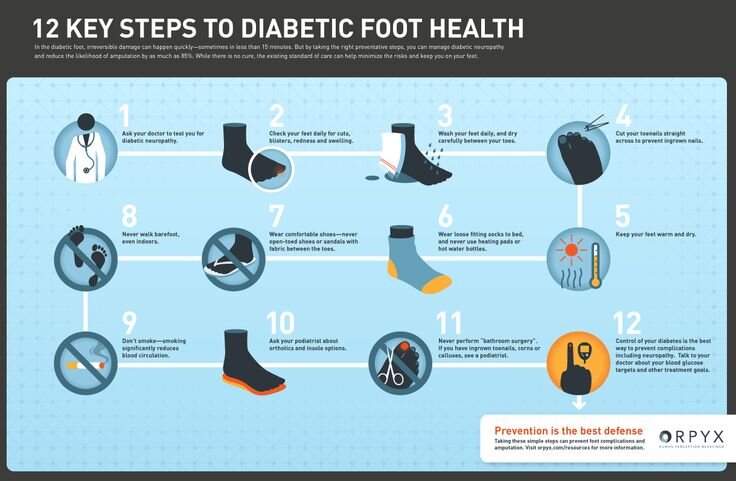Managing diabetes often comes with a variety of challenges. One common issue experienced by many is diabetic foot pain. This painful condition can make daily activities difficult and negatively impact quality of life. But don't worry, there are home remedies available to manage and provide relief from this discomfort.

As we explore these home remedies, it's essential to note that these approaches should be used in conjunction with proper medical care and following your doctor's recommendations. Maintaining a healthy lifestyle and managing blood sugar levels is vital in preventing further complications from diabetes. We'll discuss some simple and natural solutions that may provide relief from diabetic foot pain.
Understanding Diabetic Foot Pain
Diabetic foot pain is a common complication of diabetes. It typically results from nerve damage and poor blood circulation in the feet. These issues can lead to a range of painful symptoms and, if left untreated, serious complications. In this section, we'll dive into the causes, symptoms, and risk factors of diabetic foot pain to help you better understand this condition.
Causes of Diabetic Foot Pain
The primary cause of diabetic foot pain is diabetic neuropathy. It's a type of nerve damage that occurs due to high blood sugar levels. Over time, high blood sugar can damage the nerves in your extremities, particularly your feet. This can lead to pain, numbness, and tingling sensations.
Another major contributor to diabetic foot pain is poor blood circulation. Diabetes can cause damage to blood vessels, reducing blood flow to the feet. This in turn can make it difficult for your body to heal injuries and fight off infections.
Symptoms of Diabetic Foot Pain
Diabetic foot pain can manifest in a variety of ways. Some common symptoms include:
- Burning, tingling, or numbness in the feet
- Sharp or throbbing pain
- Sensitivity to touch or temperature
- Muscle weakness or loss of balance
Risk Factors for Diabetic Foot Pain
There are several factors that can increase your risk of developing diabetic foot pain:
- Duration of diabetes: The longer you have diabetes, the higher your chances are of developing diabetic neuropathy and foot pain.
- High blood sugar: Maintaining consistently high blood sugar levels can increase the likelihood of nerve damage.
- Smoking: Smoking can exacerbate poor blood circulation, further increasing the risk of diabetic foot pain.
- Obesity: Carrying excess weight puts additional pressure on blood vessels and nerves, leading to increased foot pain.
Knowing the causes, symptoms, and risk factors of diabetic foot pain is essential to effectively manage and prevent this condition. By taking active steps to maintain healthy blood sugar levels and address foot pain early, you'll be well on your way to taking care of your feet and overall health. In the following sections, we'll explore home remedies and tips for managing and preventing diabetic foot pain, along with advice on when to seek professional medical help.
Effective Home Remedies for Relief
Living with diabetic foot pain can be challenging, but there are several home remedies that can help provide relief. We've compiled a list of effective treatments to help lessen discomfort and improve overall foot health for those with diabetes.
- Control blood sugar levels: Maintaining optimal blood sugar levels is critical for preventing further nerve damage and reducing foot pain. Monitoring blood sugar regularly and following a balanced diet are essential for keeping levels in check.
- Exercise regularly
- Follow a healthy, balanced diet
- Take prescribed medications as directed
-
Over-the-counter pain relievers: Using OTC pain relievers like ibuprofen, acetaminophen, or aspirin can provide temporary relief from diabetic foot pain. Be sure to follow the recommended dosage guidelines and consult with a healthcare professional before starting any new medication.
-
Warm Epsom salt baths: Soaking feet in a warm Epsom salt bath can help alleviate muscle aches and reduce inflammation. Just mix 1/2 cup of Epsom salts with warm water in a basin or foot spa, and soak feet for 15-20 minutes.
-
Cold and hot therapy: Alternating between cold and hot packs can help reduce pain and inflammation. Apply a cold pack for 20 minutes, then switch to a warm pack for another 20 minutes. Repeat the process 2-3 times daily.
-
Massage and stretching: Gently massaging and stretching your feet can improve circulation, reduce muscle tension, and alleviate pain. Be sure to massage carefully, using light-to-moderate pressure to avoid further injury.
-
Essential oils: Certain essential oils, like lavender, peppermint, and eucalyptus, are known to possess pain-relieving properties. Dilute a few drops in a carrier oil like coconut or jojoba oil, and gently massage onto the affected area.
-
Quit smoking: Smoking can lead to poor circulation, which may exacerbate diabetic foot pain. By quitting smoking, you'll improve circulation and overall foot health.
-
Invest in proper footwear: Wearing well-fitted, supportive shoes and socks, like those available from Circufiber.com, can help alleviate foot pain and prevent skin breakdown.
Remember to always consult with your healthcare provider before starting any new home remedies, especially if you're unsure whether they're safe for your specific health needs. While these remedies can provide relief from diabetic foot pain, it's essential to continue working closely with your healthcare team to manage your diabetes and prevent further complications.
Preventing Further Complications
Taking precautionary measures is crucial when managing diabetic foot pain, to avoid further complications like infections and ulcers. Here are some practical steps we can implement to minimize the risk of complications and promote healthier feet:
-
Examine your feet daily: Checking for cuts, blisters, redness, and swelling reduces their chance of worsening. It's essential to stay on top of any changes in your feet.
-
Keep your feet clean and moisturized: Regular washing with mild soap and warm water will help maintain hygiene. After drying your feet, apply moisturizer to keep the skin from cracking, but avoid putting lotion between the toes to prevent infections.
-
Wear properly fitted shoes and socks: Opt for protective and supportive footwear to cushion the feet, reduce pressure, and minimize irritation. Specially designed diabetic socks can help improve circulation and prevent blisters.
-
Trim your toenails carefully: Cutting nails straight across and filing sharp edges aids in preventing ingrown toenails, which can lead to infections.
-
Avoid going barefoot: Even at home, wear shoes or slippers to protect your feet from unnoticed injuries.
-
Control your blood sugar: Maintaining blood sugar levels within a healthy range goes a long way in preventing complications in the feet and other parts of the body.
Moreover, engaging in some natural home remedies can also provide relief and support foot health. These include:
-
Soaking your feet: Warm footbaths with Epsom salt are known to alleviate pain and reduce inflammation. Just ensure the water isn't too hot, and always dry your feet thoroughly afterward.
-
Massage your feet: Gently massaging your feet can help improve circulation, relax tense muscles, and provide relief from pain.
-
Utilize cold or warm compresses: Applying cold or warm packs to the painful area can help reduce inflammation, alleviate pain, and improve blood flow.
-
Stay active: Engaging in regular physical activity, such as walking or swimming, can help maintain healthy blood flow and enhance overall foot health.
Although these practices can help manage diabetic foot pain, it's crucial to consult a healthcare professional if you notice any severe or persistent symptoms. They can provide expert guidance on managing your diabetes and securing the best overall care for your feet.
Conclusion: Consistent Care for Diabetic Feet
We've covered various home remedies that can help alleviate diabetic foot pain, but it's important to remember that consistent care for diabetic feet is essential. Caring for your feet will not only help manage existing pain, but also prevent complications in the long run.
Some key practices worth emphasizing for excellent diabetic foot care include:
- Inspecting feet daily
- Keeping feet clean and dry
- Moisturizing regularly, but avoiding the area between toes
- Wearing appropriate footwear
- Protecting the feet from extreme temperatures
- Trimming toenails regularly in a straight-across manner
To ensure that you're giving your feet the attention they deserve, it's crucial to adhere to a dedicated routine. This could involve incorporating these important practices into your day-to-day life.
References, Studies and Sources:
https://www.mayoclinic.org/diseases-conditions/diabetic-neuropathy/symptoms-causes/syc-20371580
https://medlineplus.gov/diabeticfoot.html
More About Circufiber.com and Healthcare disclaimer:
Always consult your physician before beginning any program. This general information is not intended to diagnose any medical condition or to replace your healthcare professional. If you experience any pain or difficulty, stop and consult your healthcare provider. Circufiber.com socks are clinically proven to improve micro-circulation in feet and lower extremities in people with Diabetes.
More Author Information:
Dr. Capozzi is a board-certified foot surgeon through the American Board of Foot and Ankle Surgery. He is a Diplomate of the American Academy of Wound Management and Fellow of the American College of Foot and Ankle Surgeons. He completed a three-year residency program in Foot and Ankle Reconstructive Surgery at St. Francis Hospital & Medical Center in Hartford, CT in 2010. Dr. Capozzi is a board-certified Wound Specialist® granted by the American Academy of Wound Management. He is also board-certified in Foot Surgery through the American Board of Foot and Ankle Surgery.





